Shock England selections explained: Why Eddie Jones has picked Porter, Freeman and Van Poortvliet

Another week, another England selection to keep tongues wagging as Eddie Jones hands out debuts to Guy Porter and Tommy Freeman. Jack van Poortvliet comes in at scrum-half, too. Never a dull moment.
Debate will rage, and yet this is a side capable of squaring the series. Porter, resourceful and tough, was one of the most important players over Leicester Tigers’ triumphant Premiership campaign. Van Poortvliet played a significant part, building on a breakthrough campaign 2020-21. Freeman is a hugely exciting talent.
This is the thinking behind the team trusted to make it 1-1.
Cokanasiga and Marchant sacrificed to keep Smith-Farrell
Although Porter and Freeman are new faces, it could be argued that their strengths make this England backline more balanced. Undoubtedly, they allow Jones to keep Marcus Smith and Owen Farrell together.
It was interesting to hear Henry Arundell reveal that his colleagues had vowed to get him the ball as soon as possible following his introduction from the bench on Saturday.
Joe Cokanasiga, the man Arundell replaced, had picked up precisely four touches of the ball until that point. This rather sparse pitch map tells the story of how England failed to bring a potentially dangerous weapon into the game:
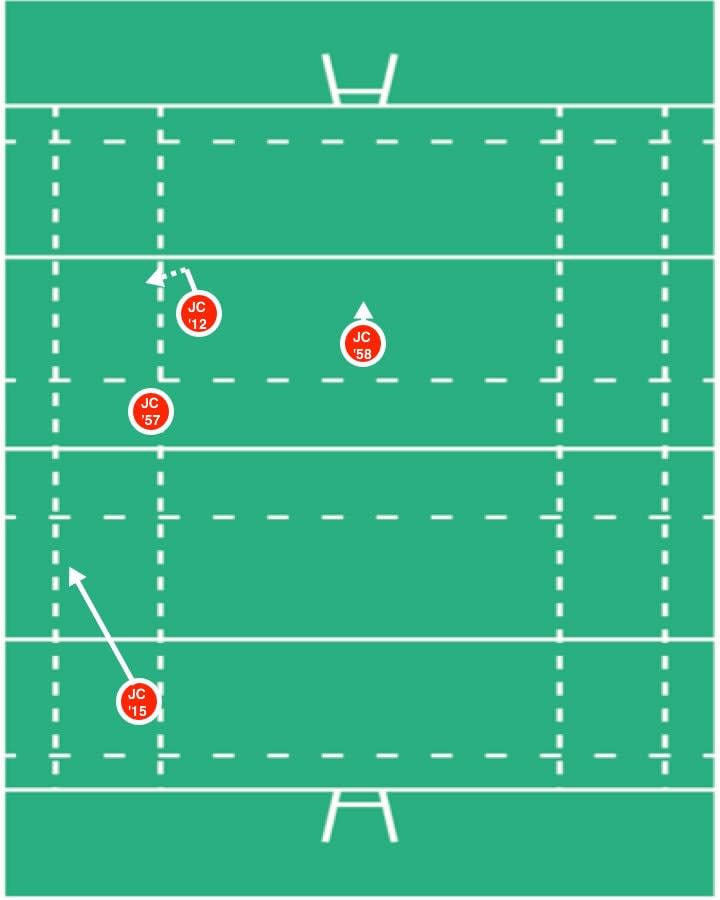
Joe Marchant’s evening was not much busier from a ball-carrying perspective. Having consistently troubled France on his previous Test appearance, the Harlequin was reasonably quiet:

Now, we know that England’s wings work in-field and their outside centre often finds themselves out wide – usually because they move there during kicking exchanges. Back in November 2020, before facing Georgia, Jonathan Joseph explained that “with England and the style we play, you get more good ball on the wing”.
Jack Nowell was prominent in Perth. He bustled around breakdowns and combined with Billy Vunipola for a surging kick-return. Farrell freed him with a neat grubber in the second half, too. With experience, Nowell has evidently learned when to let the ball come to him and when to abandon his touchline to find the ball.
Cokanasiga, however, hardly factored despite England clearly striving to keep the ball in hand. The tourists racked up 92 rucks in possession and only kicked 18 times. Three of Cokanasiga’s touches came from short passes – two from Smith and the other from Farrell – as he worked onto the shoulders of England’s dual playmakers.
This was clearly a focus for him but at one stage (the touch marked ’58 on the map), he took an inside pass from Farrell. England recycled and attempted to impart width on their left . With Cokanasiga caught up, Maro Itoje was the edge attacker and spilled a pass from Smith.
Here is another example of the centre-field focus. With 12 minutes on the clock, Cokanasiga is stacked behind Farrell and Smith in a shape England attempted to assume as often as they could. Itoje and Will Stuart are the forwards in the first wave:
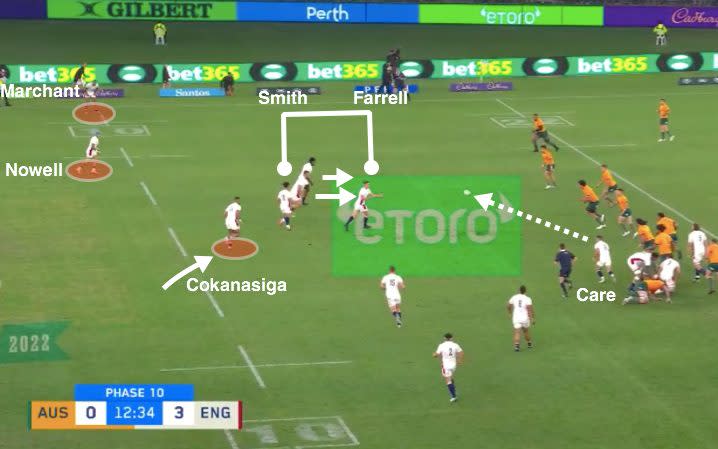
After a pull-back to Smith in the second wave, Cokanasiga takes an inside pass before offloading to Nowell, who in turn finds Marchant:
The ball movement looks fairly easy to read and the Wallabies scramble well, forcing a breakdown turnover on the next phase. Cokanasiga would only pick up three further touches before being replaced. Marchant did almost score on the right flank later in the first half from Tom Curry’s break, but came alive later on when England attacked with more conviction.
For Arundell’s try, Marchant is found quickly via two long passes by Smith and then Farrell:
From the ensuing restart, England are even quicker to feed Marchant. A beautiful in-out shuffle beats Samu Kerevi and Freddie Stewards pass towards Arundell is slapped down by Jordan Petaia:
The power of England’s forwards and their ability to fix defenders in midfield produced ample opportunities cause further damage. Here, Cokanasiga gets a charge from his own 22 and barges away Michael Hooper:
Ellis Genge maintains the momentum by carrying on the next phase and England have penalty advantage. Farrell and Smith assume their stack with two forwards, Curry and Billy Vunipola, cutting hard angles:
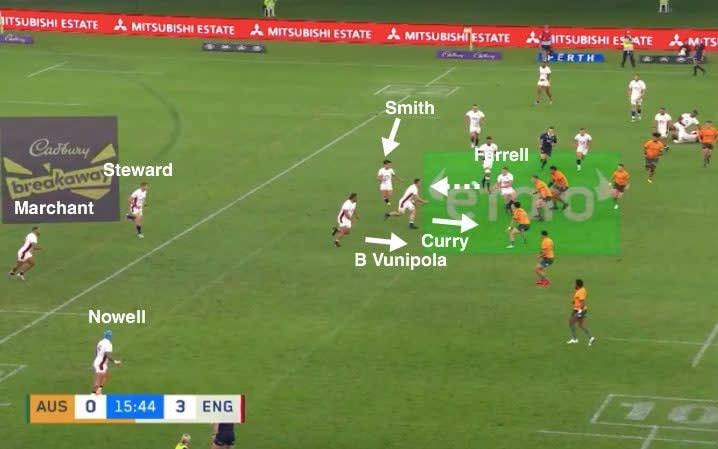
Marchant is out the back but Smith plays in Steward on a short line and a spill lets off Australia:
Cokanasiga and Marchant have paid a heavy price for a clunky England performance. The Smith-Farrell axis is retained with Porter coming in, adding punch at 13. He is another nuggety carrier, as this run in the Premiership final off the shoulder of Genge illustrates:
Porter is better suited to the heavy traffic that Marchant has been asked to navigate. Watch out for him as the point-man of this set-piece shape:
Porter will also be comfortable moving wider, having spread his appearances for Leicester between centre and wing. Tommy Freeman is similarly adaptable. We could see him at outside centre at some stage and his experience at full-back is handy for the inevitable kicking exchanges. He will certainly be happy with a remit to roam.
Van Poortvliet is the third change at scrum-half. The former England Under-20 skipper, an assured operator, will be asked to keep tempo high by speeding between rucks and fizzing away passes. He is a controlled kicker, too. All in all, the selection suggests a more direct and uncluttered attacking strategy with Danny Care and Arundell on the bench for later.
This down-side, while injury-hit Australia are forced into wholesale changes, is that there are more new combinations for England. Cohesion could be hard to come by, although Porter and Steward can lean on their existing club relationship for clarity in the 15-metre channels. Either way, the organisation of Smith and Farrell takes on greater importance.
Underhill and six-two bench for stopping power
The dynamism and efficiency of Australia’s attack contrasted sharply with the struggles endured by England. From a line-out in the 54th minute, the Wallabies fired a warning shot of what was to come in the final-quarter. Samu Kerevi is the man to watch as Lewis Ludlam stands to the inside of Smith and Farrell in the defensive line:
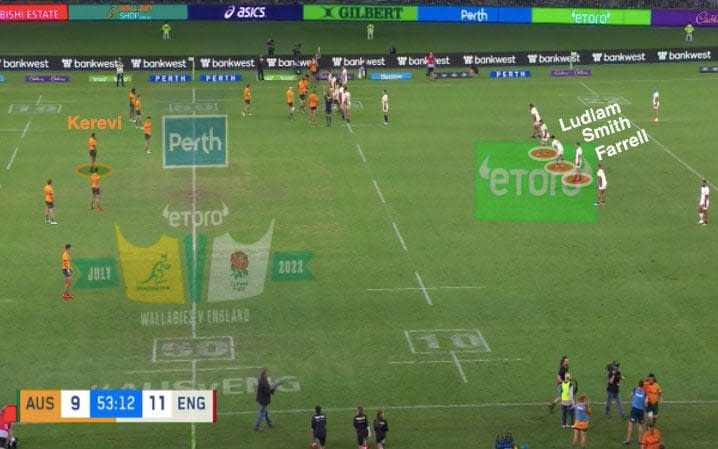
The set piece is messy, yet Kerevi is launched at England’s weak spot. He bumps away Smith and slips past Farrell before Ludlam wrestles him to the floor. Australia win rapid ball…
…but on an ’11 play’ – a quick zig-zag in the opposite direction – Nic White cannot link up with Scott Sio and England recover:
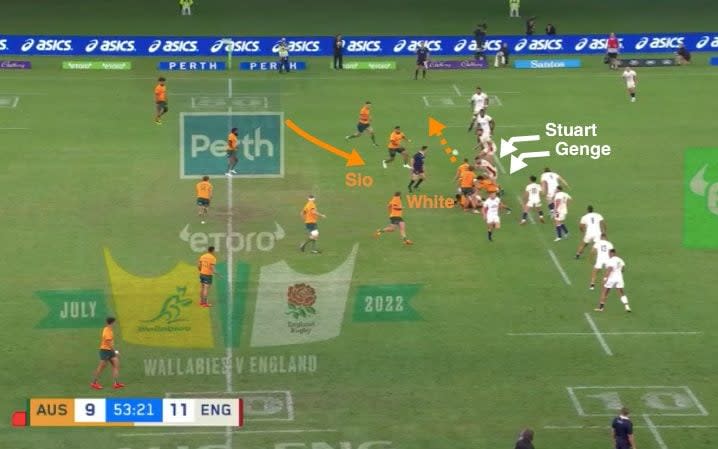
Around 15 minutes later, Pete Samu jumps in a line-out just outside the England 22. Michael Hooper burrows in…

…and curves away before passing to White. Kerevi is lurking. Track Sio as well:

Kerevi gains more ground…
…and this time White connects with Sio. Watch Noah Lolesio and Andrew Kellaway:
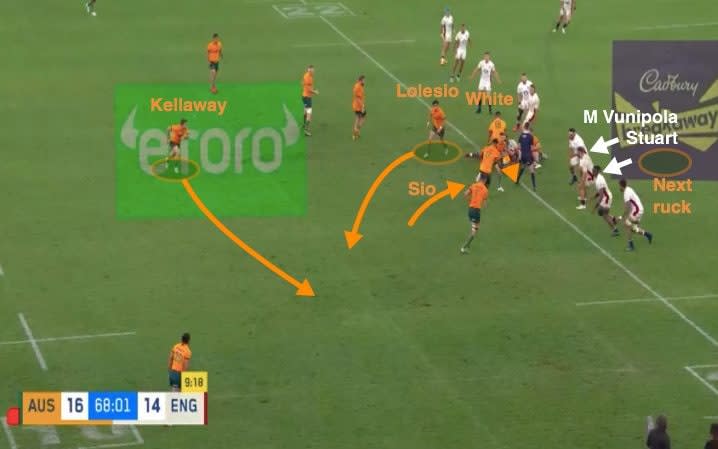
Fly-half and full-back arc around from the far side of the breakdown in a ploy typical of Scott Wisemantel teams. Kellaway’s grubber earns Australia a five-metre line-out, from which they score for a 23-14 lead:
England’s inability to disrupt Australia’s ball retention was also evident ahead of the hosts’ third try:
Sometimes defending teams will deliberately leave the ruck alone in order to crowd the defensive line. In this case, tackles have to be robust enough to slow opposition momentum.
Opta’s breakdown efficiency statistics tell a story. Australia tallied 14 effective defensive arrivals at Optus Stadium, jackalling and counter-rucking to confound England.
Across the 80 minutes, England managed just three effective defensive arrivals. Hooper registered that many on his own, and Australia racked up 14:
There is a chicken-egg conundrum here. Kerevi’s puncturing runs aimed at the Smith-Farrell link produced quick ball time and again. But Billy Vunipola, Genge and Nowell caused dents, too.
Occasionally, it was as if England were concerned that an unfamiliar referee, James Doleman, might penalise their jackalling attempts. Lawes, Curry and Genge were all penalised for contesting illegally.
Australia did not die wondering. With Andrew Brace taking the whistle for the second Test, that approach should not change.
Underhill and Porter provide England with stopping power, while the presence of Luke Cowan-Dickie and Jack Willis on the bench pose a pair of elite jackalling threats.
A six-two split of forwards, aided by the versatility of England’s backs, gives them no excuses for lulling over the 80 minutes and places onus on Eddie Jones to use his replacements wisely.
Taniela Tupou’s return gives the Wallabies another rampaging runner and Hunter Paisami joins Kerevi in midfield. England’s defence will need to control the pace far better than they managed in the series-opener.
Do that, and they can force a decider.
What team-mates think of England's new faces
Tommy Freeman
England’s wings have licence to roam off their flank to pick up touches in midfield. Ideally, though, they will know when to hug the touchlines to offer width as well. Nowell covered both bases in the first Test, striking a nice balance.
Cokanasiga was more of a passenger because he seemed fixated on offering himself to either Smith or Farrell up the middle of the pitch. By the time Arundell replaced him, Cokanasiga had only registered four touches.
Jones has introduced Freeman, a 21-year-old whom he says “finds the ball”. Lawes has had a good view of Freeman’s fine season at club level. He rates Freeman as “one of the most talented wingers I have seen come through”.
“He’s very fast, very strong, he’s got great hands, he’s good at kicking... and he’s very tall so he’s quite good in the air as well,” said the England skipper. “I’ll make sure he doesn’t read any papers in the next couple of days now!”
Even if he does get wind of such praise, Freeman seems to be the sort of character to take it in his stride. He was released by Leicester as a youngster – Steward remembers being on Tigers kids camps in Norfolk with Freeman at the age of nine or 10 – but bounced back to earn recognition with Saints. Freeman’s emergence since then has been assured and impressive.
Guy Porter
There was a glint in Jones’ eye before England left for Australia when he outlined what a strong Leicester Tigers contingent, coached by his old lieutenant in Steve Borthwick, would offer.
“They know how to play Test rugby,” was his answer. Porter, an unused replacement in Perth, has been promoted to start on his England debut. At various stages over the past fortnight, Jones has praised the 25-year-old’s “punch” and “aggression”.
Porter, capable on the wing, is also versatile. That is valuable for two reasons. First, England’s outside centres have often cycled out wide during phase-play and in kicking exchanges – Marchant did so during the series-opener. Second, it allows Jones to pick six forwards on the bench.
Nuggety and tough, Porter provides defensive stopping power and a hole-punching foil for the axis of Smith and Farrell.
“He is a proper unsung hero,” said Steward of his Tigers colleague. “He does the dirty work really well and works unbelievably hard for the team. He empties himself every time.”
“Momentum in attack is massive,” Steward added. “The quicker the ball you get, the speed of the ruck and obviously if you get a dominant carry you get quicker ball and the defence is less organised and you can get on top of them. That is massive for us.
“Guy is someone who can get over the gain-line. He has done it all season and will be a real asset for us.”
Jack van Poortvliet
Australia had been reduced to 13 men by the time Van Poortvliet sniped over for a debut try last weekend, but his impact will not have been a surprise to those who have followed his progress for Leicester.
With a pair of useful mentors in Ben Youngs and Richard Wigglesworth, the former England Under-20 skipper has consolidated his breakthrough campaign in 2020-21.
His performance in the away victory over Clermont, inspiring what was arguably Tigers’ most complete display of a special season, oozed authority. Jones has sensed similar control and conviction.
“He’s an exciting young player,” said the England head coach of Van Poortvliet. “He's got good command of the forward pack, good communication skills, a good kicking game and a fast pass.
“We believe that Danny [Care] will be useful in the last 20 or 30 minutes of the game [from the bench].”
Care himself has been impressed: “Farmer strength – the kid’s so strong!” said the tour’s senior scrum-half last week. “He reminds me a lot of Ben Youngs. They are both farmers and you can see he’s learned a lot from [Youngs] and Richard Wigglesworth.
“He’s a great lad, always asking questions and eager to learn. I’ve been a big fan watching him play for Leicester over the years.”

 Yahoo Sport
Yahoo Sport 





































